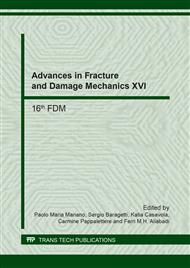p.359
p.363
p.367
p.371
p.375
p.379
p.383
p.387
p.391
Measurement of Weld Mechanical Properties Using an Instrumented Indentation Technique
Abstract:
Different microstructures in the weld zone of a metal structure including a fusion zone and a heat affected zone, are formed as compared to the base material. Consequently, the mechanical properties in the weld zone are different from those in the base material to a certain degree owing to different microstructures and residual welding stresses. When a welded structure is loaded, the mechanical behavior of the welded structure might be different from the case of a structure with homogeneous mechanical properties. It is known that obtaining the mechanical properties in the weld is generally difficult owing to the narrow regions of the weld and interfaces. As an alternative way to obtain the weld mechanical properties, the weld mechanical properties of Alloy800HT, SUS316L, and Alloy617, were recently measured using an instrumented indentation technique, and the representative weld mechanical properties of these materials were estimated with a 95% lower confidence level for later structural analyses of the welded structures.
Info:
Periodical:
Pages:
383-386
Citation:
Online since:
September 2017
Authors:
Price:
Сopyright:
© 2017 Trans Tech Publications Ltd. All Rights Reserved
Share:
Citation:


